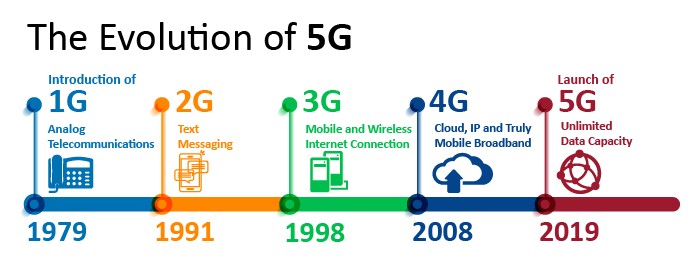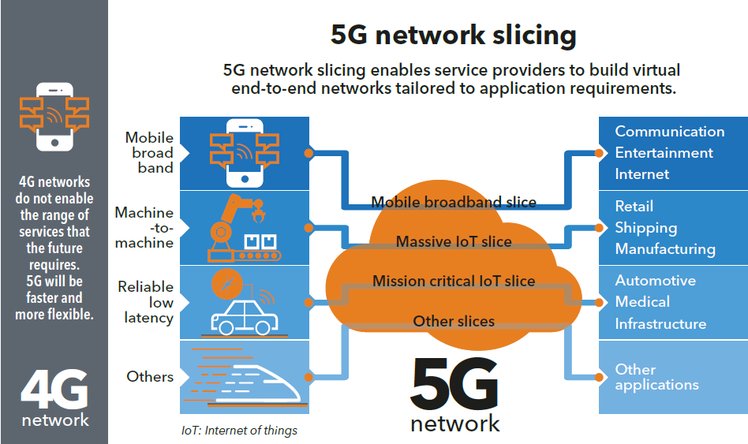
The roll out of 5G technology provides one of the largest potential benefits to manufacturers for a decade. Those who utilise this new tech will have an incredible competitive advantage over their competitors. 5G in manufacturing will be the technology that brings the Industry 4.0 factory to life.
How is 5G an Improvement?
5G represents a large jump from 4G in several different ways.
First, the speed of 5G is superior. You can expect an average of 200-400mb speeds from 5G, up from an average of 25mb on 4G. Hypothetically, gigabyte speeds will even be possible on 5G, although this is likely to only exist in a perfect test environment.
Second, the latency of 5G will be significantly shorter than 4G. While 4G is a respectable 20-30ms, 5G will lower this to under 10ms with best-case scenarios able to show 1ms. This reduced latency is one of the major factors that will drive adoption of 5G in manufacturing, opening up new ways of working for machinery.
Last, current 4G technology can support around 4000 devices per square kilometre. This will be eclipsed by 5G that will support nearly 1 million devices in the same size of space!

5G in Manufacturing
The utilisation of 5G in manufacturing is set to provide a solution to common challenges that businesses face. Reduced energy costs, increased security, and the ability to handle the growth of the number of devices connected and the data they bring are only a few of the ways 5G will benefit business.
Increasing productivity should always be on the mind of manufacturers. As product cycles have shortened, having a better production process is more important for maintaining profit. The speed and reliability of 5G will free machines from cables, allowing for more flexible and autonomous operations across the factory. No longer will they be confined to one area or task, being able to adapt to different working environments.
Furthermore, by using sensors on equipment, 5G can send data in real time which can detect faults in a manufacturing process. Due to one millisecond latency, it is possible to stop tools working before they have the chance to produce an error. This leads to a lower error and waste rate and can be used across a manufacturing process, potentially saving millions depending on the size of an operation.
While tests numbers are still small, initial results are very promising. In one factory, the error rate of precise manufacturing went from 25% down to 15%. This reduced the average cost of producing one item by €3600. This was due to the real time communication that 5G provided, allowing for adjustments on the fly and better monitoring of problems before they arise. With current technology these types of adjustments are impossible as data is not transferred quick enough.
Security on 5G has also received an upgrade thanks to the new ability to “slice” the spectrum. This can create a dedicated network with tailored capacity, coverage, encryption, security, and speed. The benefits here are that it is possible to separate sensitive data to reduce the chance of interference with it. Also, sliced networks allow for machines to only communicate with others close by, further reducing latency times.

When all these benefits of 5G are combined, it could make for a very attractive saving in costs, time, and speed.
Possible Flaws
While this all seems great, it is worthwhile remembering a few things.
Currently, much of the numbers being quoted are based on tests in ideal conditions. Without interference or mass usage, the speed and latency will always be at their best. Even if average numbers are below best-case scenarios it will still be a significant increase over 4G that will provide new ways of working.
It is also worth considering how soon to adopt this technology. Coverage and features will continue to improve over time as more providers support 5G and open the spectrum for use. Therefore, it is worth understanding what you would need to be able to reach your ideal factory set-up and ensuring that it is possible in the early stages of 5G.
As 5G is a new technology it has the potential to have teething problems. Setting up a smart factory relying on the technology is not a solved problem. Not enough experimenting or real-world testing has taken place yet to find what works and what doesn’t. Depending on your risk tolerance to obtaining a competitive advantage, this could be a positive or a negative.
Summary
While many industries will see benefits as 5G rolls out, manufacturing is in a great place to capitalise more than other industries. Product lifecycles will continue to decline. Customer demand for bespoke products will continue to increase. To remain competitive, you will need new ways of working that are more efficient. 5G can power the technology you need to adapt to these new challenges while boosting your productivity to remain profitable.

